Exercise is just as good for the brain as it is for the body, a growing body of research is showing. And one kind in particular—aerobic exercise—appears to be king.
“Back in the day, the majority of exercise studies focused on the parts of the body from the neck down, like the heart and lungs,” says Ozioma Okonkwo, assistant professor of medicine at the University of Wisconsin School of Medicine and Public Health. “But now we are finding that we need to go north, to the brain, to show the true benefits of a physically active lifestyle on an individual.”
Exercise might be a simple way for people to cut down their risk for memory loss and Alzheimer's disease, even for those who are genetically at risk for the disease. In a June study published in the Journal of Alzheimer’s Disease, Okonkwo followed 93 adults who had at least one parent with Alzheimer’s disease, at least one gene linked to Alzheimer’s, or both. People in the study who spent at least 68 minutes a day doing moderate physical activity had better glucose metabolism—which signals a healthy brain—compared to people who did less.
The brain benefits of exercise go beyond disease prevention. Okonkwo has also shown that people who exercise have greater brain volume in areas of the brain associated with reasoning and executive function. “We’ve done a series of studies showing that increased aerobic capacity boosts brain structure, function and cognition ,” he says, “Other people have found exercise can improve mood.” Okonkwo’s research has also shown that exercise can diminish the impact of brain changes on cognition, not just prevent it. “Exercise is the full package," he says.
Exercise likely improves brain health through a variety of ways. It makes the heart beat faster, which increases blood flow to the brain. This blood delivers oxygen—a good thing, since the brain is the biggest consumer of oxygen in the body. Physical activity also increases levels of brain-derived neurotrophic factor (BDNF), which i s known to help repair and protect brain cells from degeneration as well as help grow new brain cells and neurons, says Okonkwo .
In one study. Joe Northey, a PhD candidate at the University of Canberra Research Institute for Sport and Exercise in Australia, showed that when people ride a stationary bike, they experience increased blood flow to the brain, and within that blood are a range of growth factors that are responsible for cell growth and associated with improved brain function. “Considering exercise can also reduce the risks associated with common lifestyle diseases that impact the brain, such as high blood sugar and hypertension, it is further motivation to try to incorporate exercise as part of a healthy lifestyle,” says Northey.

Aerobic exercise, like running and swimming, appears to be best for brain health. That's because it increases a person’s heart rate, "which means the body pumps more blood to the brain,” says Okonkwo. But strength training, like weight lifting, may also bring benefits to the brain by increasing heart rate. The link between resistance training and better brain health is not as established, but research in the area is growing.
For now, Northey recommends a combination of the two. “Combining both is ideal," he says, for all of the other benefits exercise bestows on the body. "In addition to improving your brain function, you should expect to see improvements in cardiorespiratory fitness and muscle strength, as well as reducing the risk of obesity, diabetes and hypertension amongst other diseases.”



